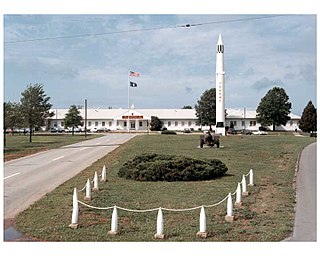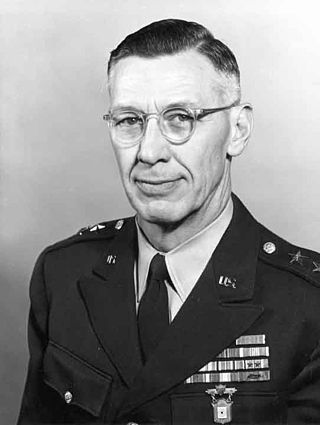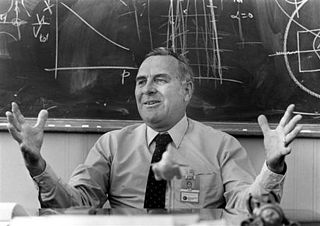
The Lunar Roving Vehicle (LRV) is a battery-powered four-wheeled rover used on the Moon in the last three missions of the American Apollo program during 1971 and 1972. It is popularly called the Moon buggy, a play on the term dune buggy.

Wernher Magnus Maximilian Freiherr von Braun was a German and American aerospace engineer and space architect. He was a member of the Nazi Party and Allgemeine SS, as well as the leading figure in the development of rocket technology in Nazi Germany and later a pioneer of rocket and space technology in the United States.

Redstone Arsenal (RSA) is a United States Army post and a census-designated place (CDP) adjacent to Huntsville in Madison County, Alabama, United States and is part of the Huntsville-Decatur Combined Statistical Area. The Arsenal is a garrison for various tenants across the Department of Defense, Department of Justice, and NASA. RSA has benefited from decisions by the Defense Base Realignment and Closure Commission. The Redstone Arsenal CDP had a residential population of 837 as of the 2020 census. The base contains a government and contractor workforce that averages 36,000 to 40,000 personnel daily.

The George C. Marshall Space Flight Center (MSFC), located in Redstone Arsenal, Alabama, is the U.S. government's civilian rocketry and spacecraft propulsion research center. As the largest NASA center, MSFC's first mission was developing the Saturn launch vehicles for the Apollo program. Marshall has been the lead center for the Space Shuttle main propulsion and external tank; payloads and related crew training; International Space Station (ISS) design and assembly; computers, networks, and information management; and the Space Launch System (SLS). Located on the Redstone Arsenal near Huntsville, MSFC is named in honor of General of the Army George C. Marshall.

The PGM-11 Redstone was the first large American ballistic missile. A short-range ballistic missile (SRBM), it was in active service with the United States Army in West Germany from June 1958 to June 1964 as part of NATO's Cold War defense of Western Europe. It was the first US missile to carry a live nuclear warhead, in the 1958 Pacific Ocean weapons test, Hardtack Teak.

The U.S. Space & Rocket Center in Huntsville, Alabama is a museum operated by the government of Alabama, showcasing rockets, achievements, and artifacts of the U.S. space program. Sometimes billed as "Earth's largest space museum", astronaut Owen Garriott described the place as, "a great way to learn about space in a town that has embraced the space program from the very beginning."
Vaino Jack Vehko was an engineer for the Chrysler Corporation.

Ernst Stuhlinger was a German-American atomic, electrical, and rocket scientist. After being brought to the United States as part of Operation Paperclip, he developed guidance systems with Wernher von Braun's team for the US Army, and later was a scientist with NASA. He was also instrumental in the development of the ion engine for long-endurance space flight, and a wide variety of scientific experiments.

Eberhard Friedrich Michael Rees was a German-American rocketry pioneer and the second director of NASA's Marshall Space Flight Center.

Konrad Dannenberg was a German-American rocket pioneer and member of the German rocket team brought to the United States after World War II.

The Redstone Test Stand or Interim Test Stand was used to develop and test fire the Redstone missile, Jupiter-C sounding rocket, Juno I launch vehicle and Mercury-Redstone launch vehicle. It was declared an Alabama Historic Civil Engineering Landmark in 1979 and a National Historic Landmark in 1985. It is located at NASA's George C. Marshall Space Flight Center (MSFC) in Huntsville, Alabama on the Redstone Arsenal, designated Building 4665. The Redstone missile was the first missile to detonate a nuclear weapon. Jupiter-C launched to test components for the Jupiter missile. Juno I put the first American satellite Explorer 1 into orbit. Mercury Redstone carried the first American astronaut Alan Shepard into space. The Redstone earned the name "Old Reliable" because of this facility and the improvements it made possible.

Major General Holger Nelson Toftoy was a United States Army career officer instrumental to the development of the United States' early rocketry after World War II, such as the Redstone missile. He persuaded senior officers to bring German scientists to the US after the war, to make use of their expertise, and supervised the relocation of more than 119 scientists.

Milton William Rosen was a United States Navy engineer and project manager in the US space program between the end of World War II and the early days of the Apollo Program. He led development of the Viking and Vanguard rockets, and was influential in the critical decisions early in NASA's history that led to the definition of the Saturn rockets, which were central to the eventual success of the American Moon landing program. He died of prostate cancer in 2014.

The Redstone family of rockets consisted of a number of American ballistic missiles, sounding rockets and expendable launch vehicles operational during the 1950s and 1960s. The first member of the Redstone family was the PGM-11 Redstone missile, from which all subsequent variations of the Redstone were derived. The Juno 1 version of the Redstone launched Explorer 1, the first U.S. orbital satellite in 1958 and the Mercury-Redstone variation carried the first two U.S. astronauts into space in 1961. The rocket was named for the Redstone Arsenal in Huntsville, Alabama where it was developed.
Georg Heinrich Patrick Baron von Tiesenhausen was a Baltic-German-born American rocket scientist.

Werner Karl Dahm was an early spaceflight scientist of the Peenemünde Future Projects Office who emigrated to the US under Operation Paperclip and was the Marshall Space Flight Center Chief Aerodynamicist.
Heinz-Hermann Koelle was an aeronautical engineer who made the preliminary designs on the rocket that would emerge as the Saturn I. Closely associated with Wernher von Braun's team at the Army Ballistic Missile Agency (ABMA), he was a member of the launch crew on Explorer 1 and later directed the Marshall Space Flight Center's involvement in Project Apollo. In 1965, he accepted the Chair of Space Technology at the Technical University of Berlin.
Helmut Justus Karl Horn was a German-American engineer and applied physicist who was employed at the early Marshall Space Flight Center. Horn worked first at the Peenemünde Army Research Center and later, after the end of World War II, was hired by the U.S. through Operation Paperclip.

Charles A. Lundquist was an early NASA scientist and program director. He managed research on satellites and rockets at the Army Ballistic Missile Agency, Marshall Space Flight Center, and Smithsonian Astrophysical Observatory. After retirement, Lundquist devoted his time to collecting and documenting early space program history, particularly that surrounding German rocket scientists in Huntsville, Alabama.
William August Schulze was a German-American rocket scientist and Operation Paperclip hire. After involvement with the development of numerous German rockets during World War II, he became one of the first seven Operation Paperclip scientists and engineers to enter the United States, where he served in directing the PGM-11 Redstone program.